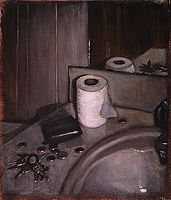|
An Interview
In which David Bailin interviews me for for his AETN
blog.
What is your basic approach to art and how has it changed?
Do I have an approach? I kind of wish I did, it would make things
easier. Even though art is supposed to bring order to chaos,
the creative process itself is very chaotic. Images come out
of nowhere - no, not out of nowhere, out of the visible or audible
world or out of some unknown or forgotten or forbidden part of
myself, or from some combination of all those - and they come,
or don't come, on their own timetable, not mine. But when they
come they demand to be made into some object. It's more of an
addiction than an approach. How does an addict approach his addiction?
An "approach" would have to
be based on ideas-like, "Let's see, what can I paint that
somebody might actually buy before I have to move under a bridge?"
But that would be a rational approach. I jokingly called a recent
exhibition of mine "Still Crazy," but there does seem
to be something seriously irrational about art. Why would a sane
person take it up? Jose Ortega says ideas are scarecrows to frighten
away reality. This is why art can be dangerous-because it can
penetrate our defenses against the truth and strip us bare. In
retrospect, I can see that my painting Flash Flood from
2002 is an illustration of this--hilarious and terrifying at
the same time! The hero myth exposed! But there's no 12-step
program that I know of.
But didn't you used to be a writer?
Yes, I was clean for about eight years
while I was trying to write the Great Apocalyptic Novel - well,
not really, because writing is just another kind of obsession,
but at least I was away from visual art. I was also on the road
with my wife and kids in a bus called Toad Hall, Mr. Toad on
a mission to save the planet, gaily bedight, a gallant knight,
in search of El Dorado (not the one in Arkansas). I wanted to
set up a self-sustaining, off-the-grid, solar-and pig-shit-powered
homestead and write about it, thus preventing the coming industrial-ecological
collapse.
| |
But he grew old --
This knight so bold --
And -- o'er his heart a shadow
Fell as he found
No spot of ground
That looked like El Dorado.
(From "El Dorado" byEdgar
Allen Poe)
Linocut from 1991
|
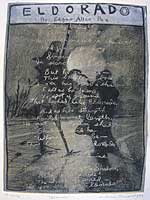
Eldorado, 1999,
linocut |
Near the end of this crusade I happened to see
the watercolors of Hubert Shuptrine in a book of James Dickey's
poems. They intrigued me because of their range of values--much
deeper darks than I was used to seeing in watercolors, and in
all innocence I began to steal time from the typewriter to fool
around with watercolors. I built an "easel" that fit
onto the steering wheel of the bus. That was my first "studio"
since leaving Florida in 1972. My paintings weren't serious,
there were no ideas behind them, I was just playing. I didn't
recognize the siren's song and there was nobody to tie me to
the mast. Pretty soon I began selling my watercolors and I was
hooked again.
This was in Little Rock?
No, but this is where we ended up after
five years on the road.
My publisher had gone out of business, the
bus broke down and we had to get jobs. I discovered the photo-realists
in a show at the Arkansas Arts Center and I sort of became one
of them - but in watercolor. After a few years of this - during
which I built up a pretty good group of collectors - I realized
I had become a prisoner of both the medium and the photograph.
I had painted in oils in Florida but didn't really know what
I was doing technically, and now all I knew how to do was watercolor.
And the photograph had become a dictator.
So I dumped the camera cold turkey and started carrying a sketchpad
with me everywhere. I had to learn to see for the first time
and learn to draw all over again. I discovered that the camera
didn't see things the way my eyes did. Also, my work turned dark,
both tonally and thematically, too dark for watercolor and Arkansas.
I got good at drawing in the dark, inside strip clubs and on
the shoulders of highways at night.
I lost all my collectors and my gallery strongly
advised me to lighten up, but it was no use. I can't seem to
do art unless I'm discovering something new. You asked me before
why I work in so many different media, and I said it's because
I'm easily bored, but what that means is that I have to keep
making new discoveries or I run out of steam. I can't "search"
for discoveries because I don't know what I'm looking for, but
by working in 2, 3, and 4 dimensions, maybe I'm expanding the
field of possibilities. It's like what Faust said to the Devil:
"When I've seen it all and done it all, to hell with it."
So one of the things I discovered at that time
was the futility of trying to be unique. Modernism was over,
we had stripped art of everything we could think of, even the
art object itself, trying to get down to the essence, leaving
only the "concept" behind like a ghost. There was nothing
more to get rid of, Number One was a monkey, and painting was
dead. Somehow that seemed liberating to me. I had always loved
the paintings of Caravaggio and Rembrandt and now I felt free
to try that myself. I got all the books I could find on Old Master
painting techniques, learned how to make paint from dry pigments,
the panels and canvases they used, the whole nine yards. The
upshot was that only after I started imitating Rembrandt did
people start saying my paintings were unique!
A lot of your themes at that time came from mythology. What books
inspired you?
Well, "themes" sounds like something premeditated.
I was never that organized. But I was reading Joseph Campbell
and Robert Graves, and I realized that myth and religion were
not only attempts to deny death, as Ernest Becker says, but were
also timeless reflections of our psyches. All our hungers and
fears, joys and miseries, all our psychoses and obsessions were
dramatized in myths long before Freud and Jung discovered them
in our heads. So all my mythological images are set in my own
time, and I'm usually the protagonist. Okay, always the protagonist.
I used to think I used myself as a model because I couldn't afford
a real model , and it wasn't really me in the paintings, but
eventually I realized it was me after all. I was Acteon and the
Crab King and all the others. This is what can happen when you
go with the images first and deal with the ideas later. You reveal
yourself without knowing it. But if I ask the Muse, "What
do you mean by that?" nothing will get painted.
Another book that ended up generating a long series of paintings
that I didn't know was a series was Dostoyevsky's The Brothers
Karamazov, specifically the chapter called "The Grand
Inquisitor," Ivan's story about a second coming of Christ
during the Spanish Inquisition. It was about this time that I
was becoming fascinated by the concept of the double, the döppelganger,
and I had also been looking at El Greco's portrait of Cardinal
Niño de Guevara, and the image I got was a kind of twisted
conflation of all that. I painted myself as both the Cardinal
and the prisoner and called it "The Question," a title
I think I got from Sartre's Being and Nothingness, which
I was also reading at the time. Sartre said the question breaks
open the egg of the closed universe.
That was in 1991, and for years after that
everything I painted had these guys in it! For me they symbolized
the existential paradox - that we are animals with self-consciousness,
and the animal and the self can neither be reconciled nor separated.
For "animal" read "image," and for "self"
read "idea." You can't have one without the other,
and "The Question" can never be answered.
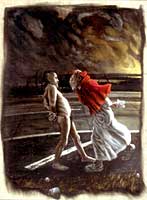
The Storm, 1992,
oil on linen,
48 x 36 inches |
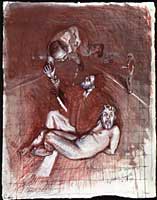
Study for "Hiway 61",
1993, conte & acrylic on
paper, 34 x 26 inches |
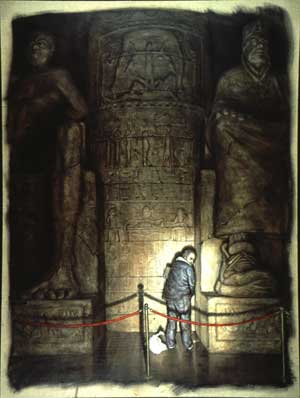
The Trespasser,
1993, oil/wax on linen,
60 x 48 in. |
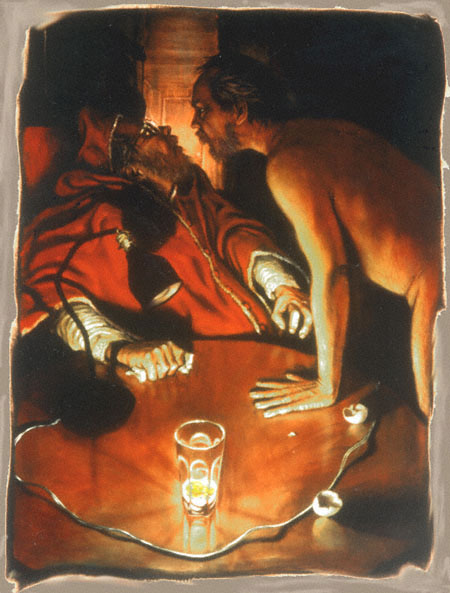
The Kiss, 1992,
oil on linen, 48 x 36 inches |
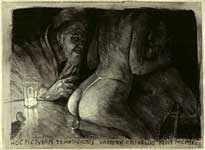 The Temptation, 1991, The Temptation, 1991,
charcoal & spray enamel
on paper, 28 x 38 in. |
But I was so locked up in all this - as in
A Man Reading - that life was passing me by, and I finally
managed to break out of it. The last one was All the King's
Horses. They were gone, egg and all.
Since then you've gotten into sculpture,
printmaking and animation. What were the biggest changes to your
work over the years?
1189i.jpg)
Roadkill, bronze,
2010, 9 x 8 x 13 inches |
to New York
in 2005 where I saw an animated film by William Kentridge.
That started me on a whole other addiction! Now I could bring
my images to life - after the year or so It took me to learn
how to do it. It was a fateful investigation into time itself,
into the moments that we never see because they go by too fast.
I had to do 24 drawings to get 1 second of video, so I had to
slow down my creative metabolism to a crawl. It brings us back
to the insanity of art, but I was hooked. I had become Dr. Frankenstein.
"It's aliiiiiiiive!" |
But aside from the technical problems, working
in the fourth dimension had a profound influence on my other
work. These "images" I've been talking about were always
that perfect moment that you could immortalize on paper or canvas
or in bronze or whatever. But now that perfect moment had a past
and a future, a beginning and an end. I had brought my images
to life, but I also brought them to death. I was right back at
that existential dilemma: no life without death. Now when I did
a painting it looked like a multiple exposure photo.
I found I could do this even with sculpture-show
movement and transparency in a solid opaque material. Thinking
about it now, that seems like another metaphor for existence
vs. essence, image vs. idea, animal vs. self.
But maybe my work hasn't changed as much thematically
as it has technically. For instance, the double has haunted my
work ever since "The Question." My last animation is
an example. Aristeas is supposed to have left his body in the
form of a raven and hung out with Apollo for years in a state
of ecstasy. This is the double! One part of us wants freedom,
the other part wants security. One part loves chaos, the other
needs order. The animal is immortal, the self knows it will die.
In the Inuit religion Raven is both the creator of the universe
and a trickster, a dirty old man. The crow, you know, has been
in my images for a long time. The raven and the crow, for all
their intelligence and beauty, live on dead animals, so they
are natural symbols for man with his double nature.
Art seems to exist at the interface of this duality,
drawing its energy from both sides. If it expresses just one
side or the other-the beauty without the ugliness, the humor
without the pain - it seems empty or trivial. To me, anyway.
Sometimes the images that ambush me do indeed seem trivial: a
roll of toilet paper, a coffee cup, the night sky. But maybe
something in my unconscious - my muse! - recognizes that duality,
the idea in the image, even though I don't figure it out until
later. But I think the artist lives for those stunning moments,
and then seeing them reborn from his own hands, and always in
fear that they will abandon him. That's the addiction.
So what's going on in your head now?
You don't want to know.
No, seriously. What's happening in the studio? What are you
reading?
Janet took a picture of me with her phone last week while I was
reading in bed. Actually, I was asleep. I always denied that
I dropped off while reading, so this was her proof. It was a
joke shot, the old fart snoring over his book, but something
about the composition or the lighting grabbed me. It turned out
to be one of those unexpected moments, so I went with it. Hey,
the muse had not been singing, I had nothing else going, give
me a break. The next day I did a monotype from the photo, and
now I'm working on a painting and a linocut. It's called "Sleep
Reading," a variation of speed reading.
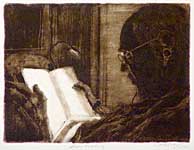
Sleep Reading,
2012, monotype,
image 8 x 10 ½ inches |
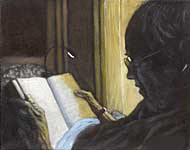
Sleep Reading,
2012, oil on canvas, 16 x 20 inches,
in progress |
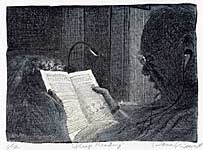
Sleep Reading,
2-color linocut,
image 5 x 7 inches, edition of 12 |
The book I was sleep reading is called From
Eternity to Here by Sean Carroll, and it's about time - actually,
about how time is a function of entropy and the Second Law of
Thermodynamics. I'm also reading a book called The Botany
of Desire, which basically asks the question, "Did we
domesticate the apple, or did the apple domesticate us?"
And before that I read E.O. Wilson's The Social Conquest of
Earth, which shows that, existentially speaking, there's
not that much difference between humans and ants, except that
ants are altruistic robots and humans are more destructive. I
should also mention that a few months ago I read the 30-year
update of the book which started me off on my crusade to save
the world, Limits to Growth, and found that nothing had
changed in the data since then to slow down the exponential growth
of population, pollution and fossil fuel use and that we were
even deeper into overshoot mode than back then. The ecological-industrial
collapse was still on schedule for around 2050. But the books
I mentioned, as well as my Aristeas animation, are giving me
a somewhat different view of this than I had in my activist phase
back in '72.
Working on the waves in the background of Aristeas, drawing frame
after frame, plenty of time to think, I began to see everything
as a wave. Careers, individuals, civilizations, species, ecosystems,
all roll along in an orderly way, lowering their own entropy
(that is, their chaos) by raising that of their neighbors, until
they encounter some obstacle, like a beach or the food runs out,
or the oil, and then they may rise up in a magnificent moment
of fame and glory, go into overshoot mode, crash to the sand
and get sucked back into the sea they came from. It's just a
natural cycle. It's not us against nature. We are nature! All
of this - cars, computers, wars - it's all nature! We think we're
special because we have self-consciousness and can imagine infinity
and draw pictures and write poems, but the apple gets along just
fine, using us to spread its genes around, without imagination,
consciousness or even mobility. From the point of view of ET
a couple light years away, it wouldn't make any difference whether
we destroy the biosphere or a colliding asteroid does it, the
biosphere is toast either way. Both are just natural phenomena!
I grew up on the beach in south Florida, watching, hearing and
swimming in these waves, but I didn't really see them until now,
trying to draw their secret moments, using a surf video, seventy
years later, landlocked in Arkansas.
But the strange thing about art is that some
of its most depressing and frightening discoveries can reveal
moments of awe-inspiring beauty! There's the dichotomy of human
nature again: its self-destructive cruelty on the one hand and
its search for beauty on the other. You just finished Moby Dick
- finally! - and now you know that Captain Ahab lurks in the
hearts of all artists to some degree. We are all obsessed with
some whale or other. But remember the ending? "…and
the sea rolled on as it rolled five thousand years ago."
|


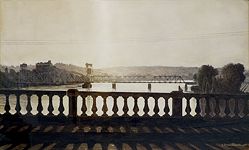
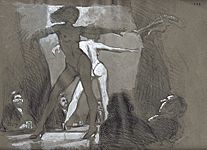

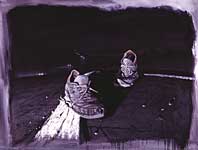
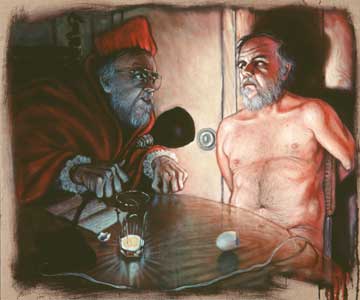



 The Temptation, 1991,
The Temptation, 1991,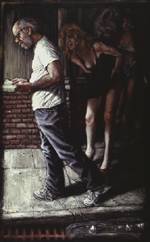
instal1333t.jpg)
1189i.jpg)
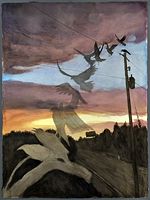
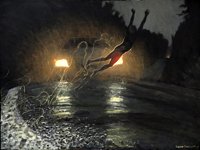
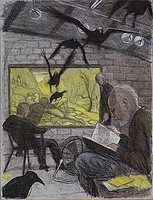
scpt-i.jpg)
